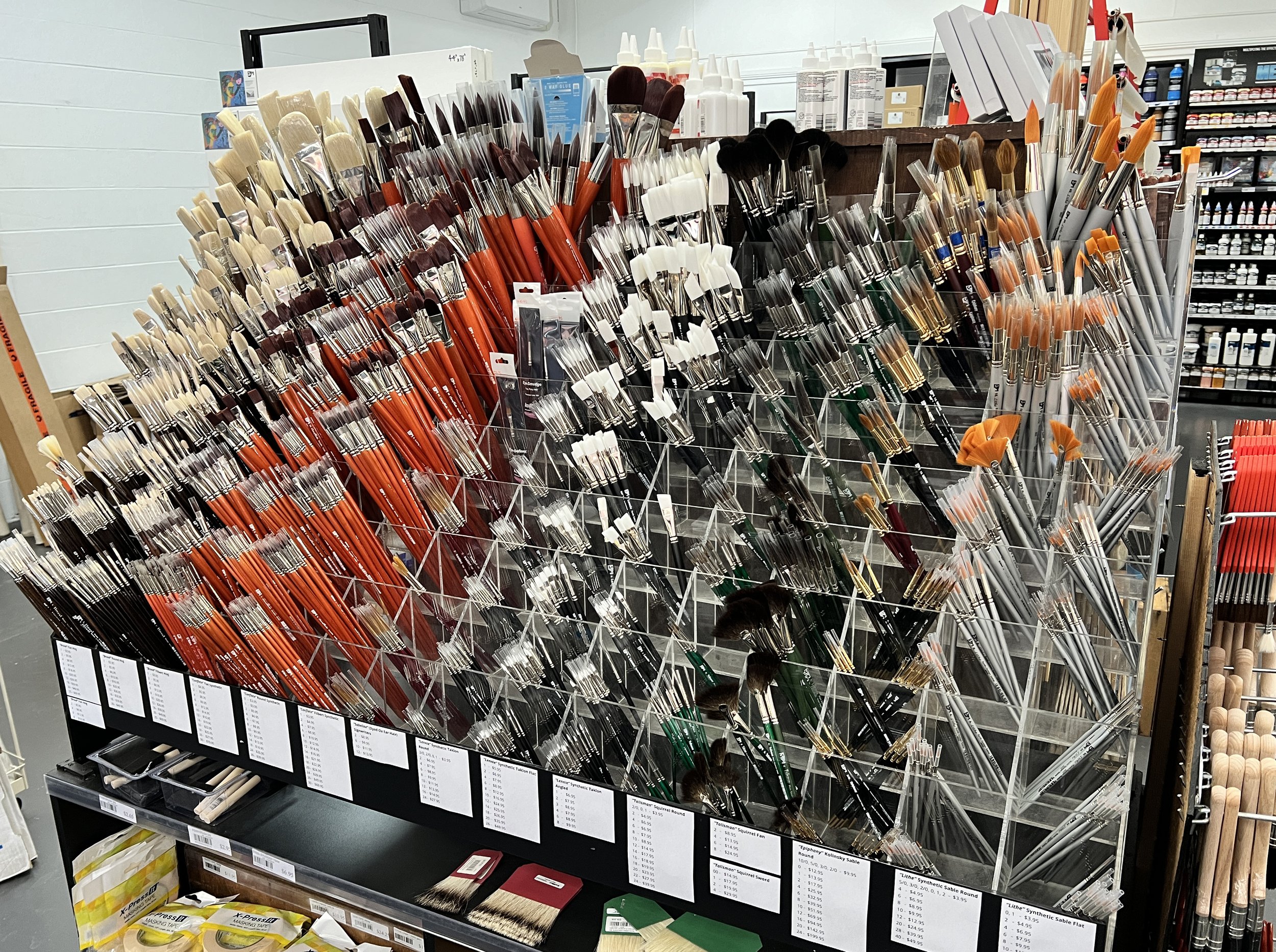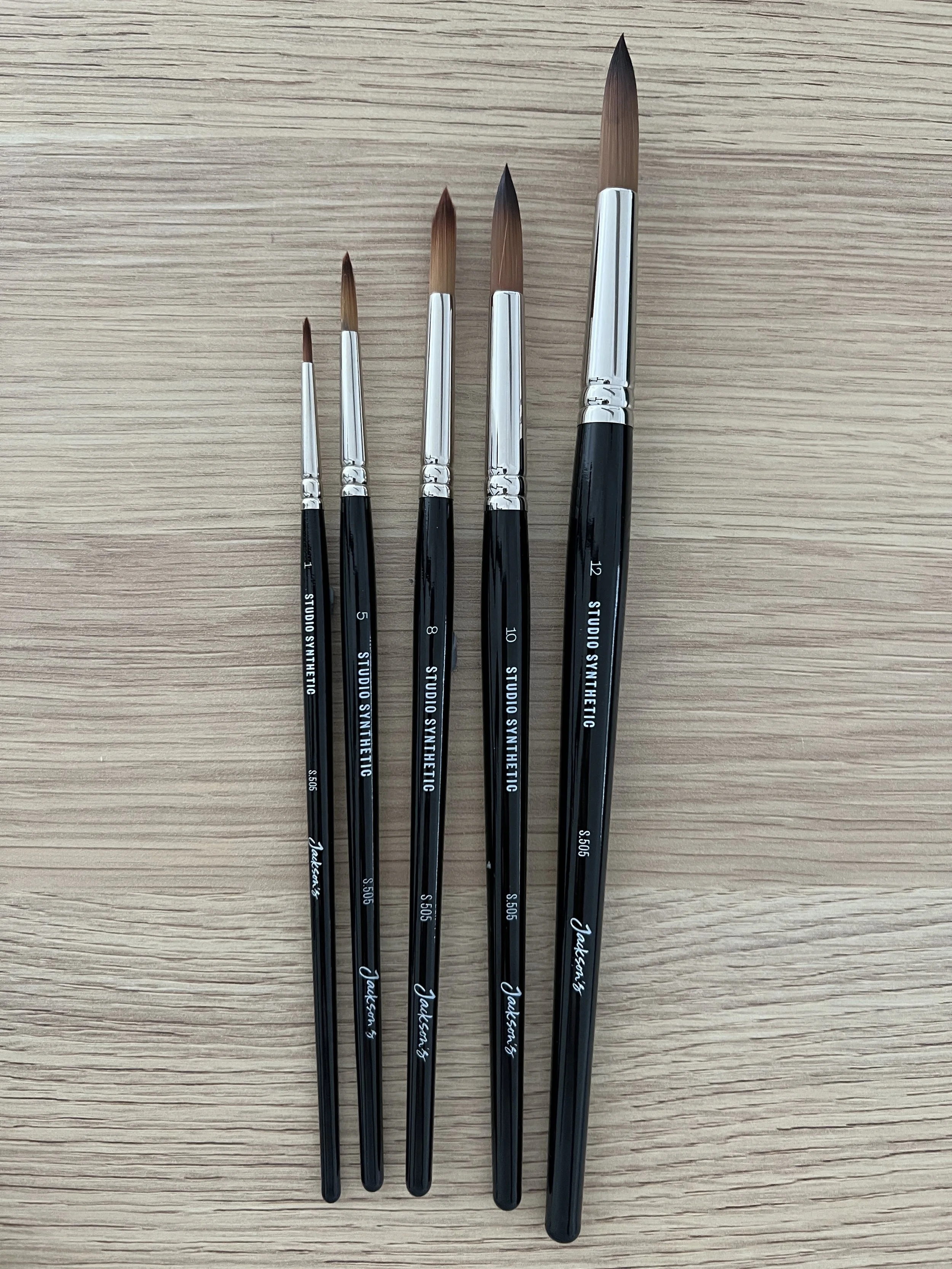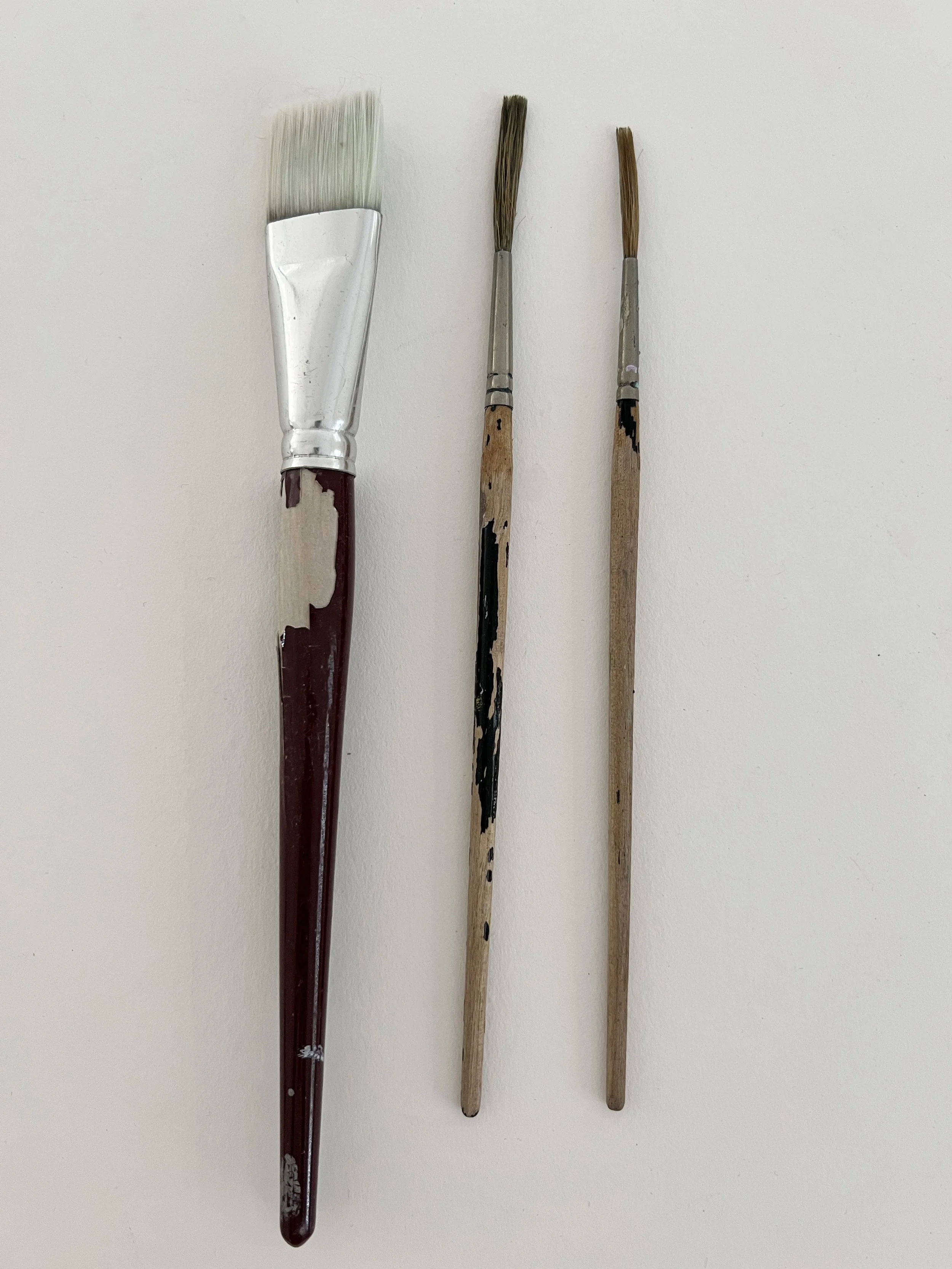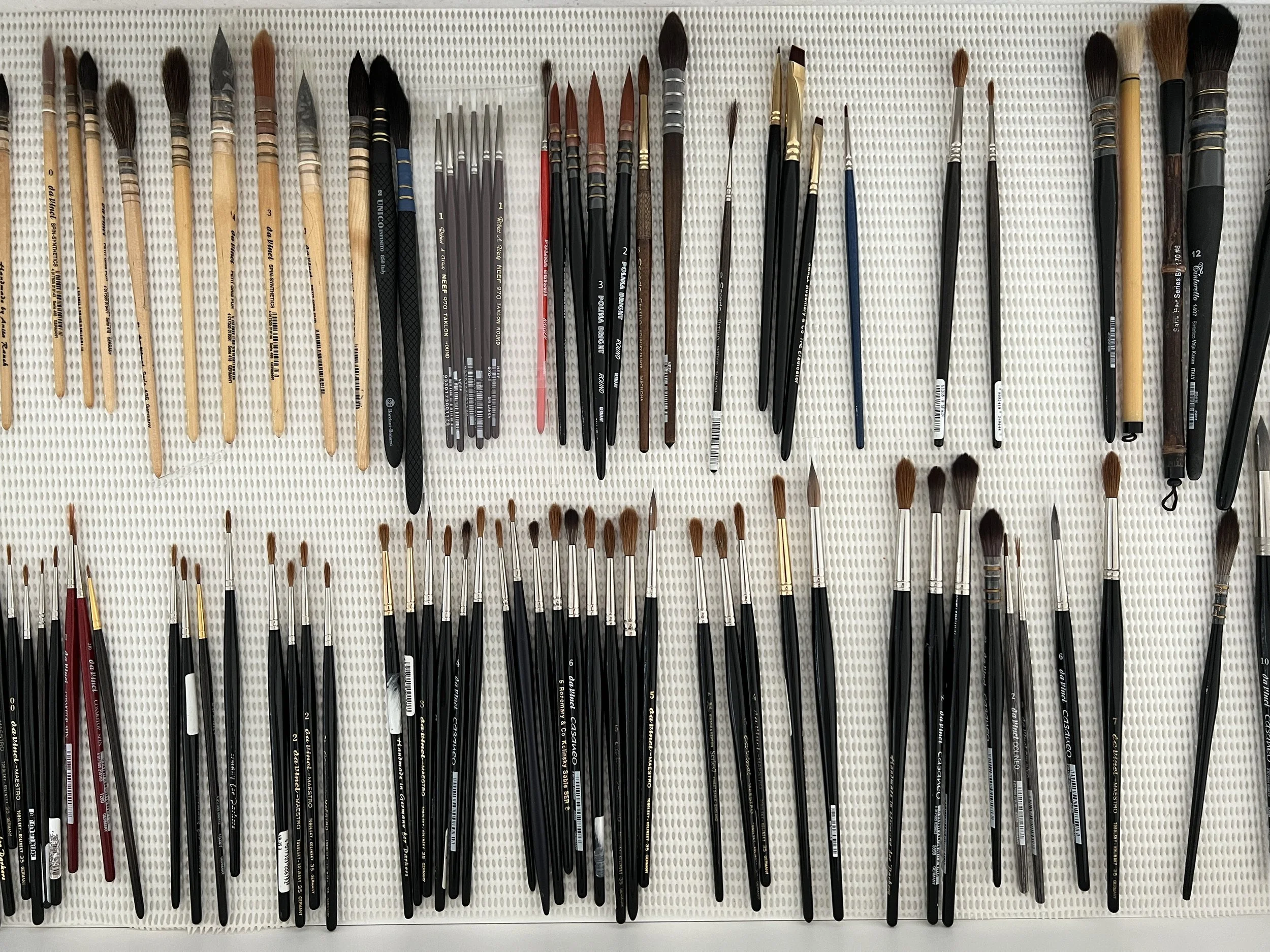The Ultimate Guide to Choosing Watercolour Brushes: An Artist's Companion
Stepping into watercolour painting introduces you to a wide array of brushes, each with its own role in bringing your art to life. Understanding the vast landscape of watercolour brushes, from the snap of synthetic bristles to the luxurious glide of sable, is essential in bringing your visions to life.
So, buckle up, my fellow art enthusiasts, as we embark on an enlightening journey through the world of watercolour brushes. You might just find your new favourite brush waiting to be discovered!
You'll need an assortment of brush sizes when you paint in watercolour.
The Brush Basics: Anatomy of Watercolour Brushes
Watercolour brushes are the backbone of your toolkit, each consisting of the bristles (the tuft), the ferrule (the metal part holding the bristles), and the handle. The type of bristle (synthetic fibers, natural hair or a mix of both), the shape of the brush (a flat ferrule or a round one), and the material of the handle (wooden handle or plastic) can significantly affect your painting experience.
Glossary
Snap refers to how well a brush returns to its original shape. Synthetic brushes often provide a better snap, which is crucial for precision work.
Spring means the brush's ability to maintain its shape under pressure. A good spring means more control over your strokes.
Capacity/Load answers the question how much water a brush can hold, influencing how often you'll need to reload your brush.
An artist's paradise: Rows of meticulously organized paintbrushes await the touch of creativity in this well-stocked art supply store.
Watercolour Brush Hair: Synthetic vs Animal Hair
The choice between synthetic and natural bristles is a matter of preference, ethics, and project needs. Synthetic brushes, made from nylon or polyester, offer durability and affordability. Natural brushes, meanwhile, provide unparalleled softness and water capacity, with sable being a top choice for many. The choice whether or not to use animal hair brushes is up to you and your artistic preferences.
A round brush with synthetic hair.
A round brush made from animal hair: Kolinsky sable.
Natural Brushes: A Detailed Exploration of hair types
Sable
Brushes made from squirrel, sable and goat hair.
Characteristics: Sable hair brushes, especially those made from Kolinsky sable, are prized for their fine tips, excellent snap, and superior ability to hold water. They maintain their shape very well, allowing for precise control over your strokes.
Applications: Ideal for detailed work, delicate lines, and fine details in your painting. Their capacity to hold a good amount of paint also makes them suitable for smooth washes that require control and precision.
Squirrel
Characteristics: Squirrel hair brushes are known for their exceptionally soft bristles and impressive water retention. They tend to have a more rounded tip and lack the snap of sable brushes.
Applications: Perfect for creating large, smooth washes and gradients. Their softness makes them less ideal for detailed work but excellent for laying down gentle layers of colour with minimal disturbance to underlying layers.
Hog
Characteristics: Hog bristle brushes are much stiffer compared to other natural fibers, offering a distinct texture. They have natural split ends, which hold more paint and create a textured effect on the paper.
Applications: These brushes are best suited for applying thick paints and creating textured surfaces or expressive brushwork. They're not typically used for fine watercolour work but can be invaluable for adding structure and texture to your paintings.
Goat
Characteristics: Goat hair brushes are soft and highly absorbent but provide less control than sable due to their floppy nature. They're often used in larger brushes.
Applications: Widely used in traditional calligraphy and broad wash techniques, goat brushes excel in creating dynamic, flowing strokes and can cover large areas quickly with water or pigment.
Synthetic Watercolour Brushes: Advancements in Brush Technology
Nylon & Polyester
Characteristics: Synthetic hair brushes made from nylon or polyester filaments are designed to mimic the properties of natural hair but with added durability and resistance to damage from paints and solvents. They can vary in stiffness and texture, with some being very soft and others more firm, depending on their intended use.
Applications: Synthetic brushes are incredibly versatile and can be used across all levels of watercolour painting. They are excellent for artists who prefer a brush that maintains its shape and offers consistent performance over time. Soft synthetic brushes can be used for smooth washes and blending, while firmer brushes are great for detailed work and building textures. Synthetic brushes are also great for lifting colour while the paint is wet. A good snap is commonly found in synthetic watercolour brushes.
The development of synthetic paint brushes has introduced a range of options for artists, combining ethical considerations with performance and durability. Whether you lean towards the traditional qualities of natural brushes or the modern resilience of synthetic options, understanding the strengths and applications of each type will enhance your painting practice, allowing you to select the best tools for your artistic vision.
Are nylon brushes good for watercolor?
Synthetic brushes are not only good for watercolor painting; they are an excellent choice for many artists. Their durability, versatility, and ethical production make them suitable for a wide range of watercolour techniques, from broad washes to fine details.
Whether you’re a beginner looking for a cost-effective way to start painting or a professional seeking reliable tools, synthetic brushes offer quality and performance that can meet—and even exceed—your painting needs.
Versatility
Synthetic brushes are engineered to mimic the qualities of natural hair brushes, offering a range of textures from soft for smooth washes to firmer bristles for detailed work. This versatility allows you to explore a wide variety of techniques with just a few brushes.
Durability
One of the standout features of synthetic brushes is their durability. They are less prone to damage from the chemicals found in paints and cleaners. Unlike natural hair brushes that can wear out more quickly, synthetic brushes maintain their shape and stiffness over time, making them a cost-effective option in the long run.
Consistent Performance
Synthetic brushes offer consistent quality and performance. Each brush is made to specific standards, ensuring uniformity in size, shape, and responsiveness. This predictability can be a significant advantage when you’re working on detailed or precision-based projects.
Water Retention and Control
Advancements in synthetic brush technology have greatly improved their water retention capabilities. Modern synthetic brushes can hold a substantial amount of water and paint, allowing for smooth, flowing strokes that are essential in watercolour painting. They also offer excellent control, making it easier to manage the flow of paint onto your paper.
Ethical and Economical Choice
Jackson’s synthetic brushes. Series 505.
For many artists, the ethical considerations of using animal hair brushes are significant. Synthetic brushes provide a cruelty-free alternative without compromising on quality. They are also generally more affordable than high-quality natural hair brushes, making them accessible to beginners and professionals alike.
Easy Maintenance
Synthetic brushes are easier to clean and maintain than natural hair brushes. They’re less likely to shed bristles and don’t require as much special care to keep them in good condition. This resilience to wear and tear makes them ideal for artists who paint frequently or are just starting to explore watercolour painting. I have recently reviewed Jackson's synthetic watercolour brushes - you can read more about them here.
Essential Watercolour Brushes: Expanding Your Toolkit
Understanding the usage or area of work for individual watercolour brush types can provide deeper insight into how each brush can serve specific aspects of your painting process. Let's delve into some of the main brush types and their applications
I like round brushes with extra fine points because they allow me to paint fine details, even with larger brushes.
Watercolour brush shapes
Round brushes
Round brushes are incredibly versatile, making them indispensable in watercolour painting. They're perfect for everything from detailed work, such as outlining and fine lines, to filling in smaller areas and even creating some wash effects.
The pointy tip of round brushes allows for precision, while the body of the brush can hold a decent amount of paint or water for broader strokes. Make sure to look out for round brushes with a fine point to get into all nooks and crannies.
Flat Brushes
Flat brushes have a squared-off tip and are ideal for producing bold, straight lines, sharp edges, and filling in large areas with colour. They work well for painting structures, like buildings or horizons, and can be used on their edge for thinner lines. These brushes are also great for varnishing and applying broad washes.
Mop Brushes
A mop is a round, full version of the wash brush. Just like wash brushes, mop brushes, with their large, rounded shape, excel at laying down large washes of colour and creating smooth gradients. They can hold a lot of water and paint, making them perfect for wet-on-wet techniques and covering big surfaces quickly and efficiently without leaving streaks.
Flat brushes.
A filbert brush.
Mop brushes.
Filbert Brushes
The filbert brush, with its oval-shaped tip, is a hybrid between round and flat brushes, offering the benefits of both. It’s great for blending and softening edges, as well as creating varied stroke widths. This brush is particularly useful for painting petals, leaves, and other natural forms with a soft, rounded appearance.
Liner Brushes
Liner brushes, also known as riggers, have long, thin bristles and are designed for fine line work. They're excellent for adding detail, such as branches, grasses, or the rigging of ships, hence the name. Continuous lines are very easy with their help. They can also be used for lettering and signing your artwork.
Liner (rigger) brushes.
A Fan brush.
Fan Brushes
A Fan brush has bristles spread out in a fan shape and is primarily used for blending and creating textures, such as foliage, grass, and water effects. It can also be lightly used to create a soft, textured finish on a painting.
Cat’s Tongue Brushes
The cat’s tongue brush is a versatile tool that combines the features of both round and flat brushes but comes to a pointed tip. It can be used for broad washes when used flat against the paper and for fine lines or details when used on the tip, making it particularly handy for floral and petal shapes or smooth gradients.
Additional Brush Types to Explore
Quill Brushes: Excellent for large washes and calligraphic work.
Angular Brushes: Ideal for precise strokes and curves.
Dagger Brushes: Unique for sweeping strokes and fine details.
Rigger or Script Brushes: A rigger brush is perfect for long straight thin lines and some detail work.
A range of exercises by Louise De Masi.
Hake Brush: Traditional Japanese brushes with soft, wide bristles for covering large areas with smooth washes.
Understanding the specific uses and strengths of each brush type can greatly enhance your painting technique, allowing you to choose the best tool for each aspect of your artwork. Experimentation is key, as it helps you to discover the unique effects each brush can create and how it can fit into your overall painting process.
To help you hone your watercolour brush skills I have recently published some exercises.
Caring for Your Brushes: Beyond the Basics
Rinse Well
After each painting session, it's crucial to thoroughly rinse your brushes in clean water to remove all traces of paint, no matter if you use synthetic brushes or one with natural hairs. For stubborn paint residue, a mild soap can gently cleanse the bristles without damaging them. Ensure that the water runs clear before proceeding to the next step.
Reshape the Bristles
Old brushes with paint peeling off the wooden handles.
Gently use your fingers to reshape the bristles to their original form. This step is key to preventing the bristles from drying in a splayed or bent position, which can affect your brush's performance over time.
Lay Flat to Dry
Once rinsed and reshaped, lay your brushes flat on a towel or hang them bristle-down in a brush holder to dry. This prevents water from seeping into the ferrule, which can loosen the glue holding the bristles and lead to shedding.
Avoid Soaking the Handles
Immersing the entire brush in water can cause wooden handles to swell, crack, or warp over time. This damage not only affects the brush's aesthetic but can also loosen the ferrule, compromising the brush's structural integrity.
Brush Storage: An Art in Itself
Store Dry and Upright
Ensure your brushes are completely dry before storing them to prevent mold growth. Storing them upright in a jar or a brush holder allows air to circulate around the bristles, keeping them dry and in good shape.
Never Store Wet Brushes on Their Tips
Storing brushes wet or on their tips can cause permanent damage to the bristles, altering their shape and diminishing their painting capabilities. It can also lead to water damage in the ferrule and handle.
Protect from Dust and Damage
If you’re storing brushes for an extended period, consider a protective brush case or drawer that shields them from dust and physical damage. However, make sure the storage solution is breathable to prevent moisture buildup.
Use Protective Caps Wisely
Some brushes come with protective plastic caps. While these can be useful for transporting brushes or preventing dust accumulation, ensure the bristles are completely dry before using them. Trapping moisture can lead to mold growth or bristle deformation.
Regular Maintenance Checks
Washing a brush with Da Vinci brush soap.
Periodically check your brushes for signs of wear or damage. Addressing issues early can prevent further deterioration. Occasionally, you might find that a deep cleaning session with a specialized brush cleaner or conditioner can rejuvenate old brushes, restoring some of their original softness and flexibility.
By dedicating time to the proper care and storage of your watercolour brushes, you not only preserve their quality but also enhance your painting experience. Treat your brushes with the same respect and attention you give to your art, and they will serve you well for many creative projects to come.
The Role of Watercolour Brush Sizes
While exploring different types of brushes, pay attention to brush size, which can greatly affect the outcome of your work. Larger brushes are excellent for broad washes and big strokes, while smaller brushes excel in fine details and delicate lines.
Having a range of sizes in your favourite brush types ensures you're equipped for any artistic challenge. Brush sizes can vary greatly across different brands, but they generally follow a numbering system, with lower numbers indicating smaller brushes and higher numbers indicating larger ones.
You don't need this many brushes. These are some of my round brushes that I have purchased over the past 13 years.
Brush Size Basics
The size of a brush is indicated by a number stamped on its handle. Sizes can range from 0000 (also shown as 4/0) up to 24 or even larger for some brush types. The size impacts the brush's width, thickness, and length of the bristles, which in turn affects the brush's paint holding capacity and the detail or coverage it can achieve.
Essential Brush Sizes for Beginners
A set of beginner brushes.
When starting out, you want a selection that allows for a wide range of techniques without overwhelming you with too many options. Here’s a simple, versatile set:
Small Detail Work
Round brushes Size 0 to 2: These sizes are perfect for fine details, such as outlining, small features, or adding intricate textures. Their fine tips allow for precision and control.
Versatile Medium Strokes
Round brushes Size 4 to 6: Ideal for general painting and medium-sized details. These sizes offer a good balance between paint capacity and control, making them versatile for both smaller details and filling in medium-sized areas.
Large Washes and Backgrounds
Round brushes Size 8 to 12: Larger round brushes or a flat brush in a similar size range are excellent for broad strokes, washes, and filling in large areas quickly. They can hold more paint and water, allowing for longer, flowing strokes without needing frequent reloading.
A Large Flat or Wash Brush
Flat brushes 3/4 to 1 inch: A larger flat brush is indispensable for creating wide strokes, bold lines, and for quickly covering vast areas with water or paint. It’s also useful for wetting the paper evenly before starting a wash.
Additional Considerations
Invest in good quality brushes! As with most art supplies, investing in quality materials will help you in your growth. It’s better to invest in a few high-quality brushes than a large set of low-quality ones. High-quality brushes will last longer and perform better, providing more value over time. Look for brushes that hold their shape, don't shed bristles, and maintain their spring and snap over time.
Remember, brushes can change over time. With use, a brush may lose some of its original qualities, but this doesn't mean it's no longer useful. Older watercolour brushes can find new life in creating textures or effects that newer brushes can't achieve. Embrace the evolving nature of your tools as part of your artistic journey.
As you gain experience, you’ll develop preferences for certain sizes and shapes based on your unique painting style. Some artists prefer working with a limited range of sizes for simplicity, while others may expand their collection to include specialised watercolour brushes for specific effects.
Don’t be afraid to experiment with different sizes and shapes. Sometimes, a brush size or type you didn’t initially consider can become essential to your workflow once you discover the unique effects it can create.
What size brushes are best for watercolour painting?
Starting with a small, thoughtfully selected range of brush sizes will not only help you learn the basics of watercolour painting but also allow you to explore and develop your style without the clutter of unnecessary tools.
A small round brush size 2, a medium round brush size 6, a large round size 16, and a large flat brush.
A small detail round brush (like a liner or a round size 2), a medium round brush (size 6), a large round (size 16), and a large flat brush or wash brush provide a solid foundation for exploring various techniques and subjects.
As you grow in your art journey, you'll naturally gravitate towards brushes that suit your style and technique preferences. I prefer round brushes with a belly and fine point.
In the end, the watercolour brushes you choose become an extension of your artistic intent, each stroke reflecting a part of your creative vision and technique. As you grow and evolve as an artist, so too will your relationship with your brushes, continually shaping the way you see and interpret the world in watercolour.
With your new-found knowledge, the canvas of possibility for your watercolour paintings is vast and awaiting your touch. The right brushes can transform your artistic vision into reality. Remember, the best brush is the one that feels right and brings joy to your process. So, experiment, explore, and enjoy every stroke of your journey in the colourful world of watercolour painting.
Happy painting! 🎨
If you are interested in learning to paint in watercolour, I have over 170 online, voiced over watercolour tutorials for all skill levels.
Original art, prints and merchandise are available to purchase in the shop.



























